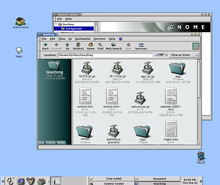User:CrustyCaverns/UNIX/Design
UNIX had some great UI design in the 1990s. This page is a standard overview of a few of my favorites. A great site to see old UI/UX design is the GUIdebook Gallery GUI section, if you're interested.


Motif, VUE, and the Common Desktop Environment
[edit]Motif, VUE, and CDE are some of my favorite old UNIX GUIs. They are characterized by light and shadow, colorful window borders, centered titles, and skeuomorphic buttons. On either side of a Motif window, you will find several buttons. On the left, you will see a dash button that, when pressed, will open a dropdown menu allowing you to manipulate the window. On the right side, there will be two buttons for minimizing the window and maximising it. Upon minimizing, or iconifying, a window, it will be moved to your desktop where you can manipulate it. CDE and VUE both have a control window at the bottom of the screen with desktop selection, pinned programs, and session controls. Motif has an icon box, but no session controls. To log out, you must right-click the blank desktop. CDE was depreciated in Solaris 11.


4Dwm and 5Dwm
[edit]4Dwm is a desktop environment which was used on Silicon Graphics' IRIX desktop operating system. It's much the same as Motif in terms of feel, but it has a distinctive beige look. A menu on the desktop, similar to NeXTstep, replaces the icon box and session controls. Iconified windows have much more detail on the icon, whereas in the Common Desktop Environment and other Motif-based desktops, the icons are generally low resolution, 16-color images. There are many gradients in 4dwm that aren't present in Motif. 5dwm is almost an exact replica of 5dwm intended to run on Linux instead of IRIX. It was never depreciated, and rode with IRIX to the end of MIPS.


NeXTstep, GNUstep, and OpenStep
[edit]NeXTstep, GNUstep, and OpenStep are largely the exact same user interface, so I won't go into detail on each of them, but they are beautifully designed UIs. They look very similar to Windows 95 in a way, but don't have nearly as much of a legacy appearance to them. NeXT windows have an X button on the right to close a window, which looks incredibly similar to Windows 95's implementation, but actually much earlier. Possibly, Microsoft even took cues from NeXT! All NeXTstep windows have a chiseled and beveled aesthetic, just like Motif and IRIX, but have them implemented more closely to Windows. The look and feel of NeXTstep are implemented in PostScript instead of just bitmaps, which means that they are drawn at runtime, creating a "dynamic" appearance. It was depreciated after Rhapsody's betas and Mac OS X Server's first builds.


Java Desktop System
[edit]The JDS is largely based on GNOME, but it has elements of Windows XP's UI design such as the "Launch" button, which opens a menu similar to the original Start menu from Windows 95-2000. Despite being called the "Java Desktop System", it is actually not written in Java. It has the same taskbar and desktop appearance as Windows XP, albeit with a different tray area and no quick start area. JDS was never depreciated, and died with the mainline Solaris project.


OpenWindows
[edit]OpenWindows was the desktop of choice for Solaris before CDE. It has distinctive frames around windows, similar to a photo album in appearance, with only one button for the window menu on most, if not all, windows. OpenWindows was depreciated in Solaris 10.


GNOME 1.0
[edit]GNOME 1 isn't even close to the desktop we know as GNOME today. GNOME 40 isn't even comparable to GNOME 2. We've strayed so far from these classic user interfaces, because with every version of GNOME, a complete redesign is in order. GNOME 1.0 was the perfect classic Linux desktop, albeit it doesn't quite age well (at least in most people's eyes). I personally think that GNOME 1 is a beautiful desktop.


KDE 1.0
[edit]Oddly enough, KDE hasn't changed much over the years. That's not to say it hasn't changed at all, but again, it hasn't changed much. KDE 1.0 is a very nice desktop with a pair of panels and some desktops akin to the Common Desktop Environment. The icons on the desktop are very nice, the background gradient is lovely, and the graphic design in general is very well thought out It is very similar to early versions of GNOME.
